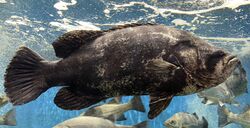Biology:Lobotidae
| Lobotidae | |
|---|---|

| |
| Atlantic tripletail (Lobotes surinamensis) | |
| Scientific classification | |
| Domain: | Eukaryota |
| Kingdom: | Animalia |
| Phylum: | Chordata |
| Class: | Actinopterygii |
| Order: | Spariformes |
| Family: | Lobotidae Gill, 1861 |
| Genera | |
|
See text | |
Lobotidae is a family of ray-finned fishes that includes the tripletails, which are circumtropical marine fishes, and tiger perches, which are Asian freshwater fishes. The family is placed in the order Spariformes in the 5th edition of Fishes of the World but this classification and the taxa included within the family is not agreed on by all workers.
Taxonomy
Lobotidae was firs proposed as a family in 1861 by the American biologist Theodore Gill.[1] The 5th edition of Fishes of the World classifies the Lobotidae within the order Spariformes and provisionally includes the genus Datnioides in the family.[2] Other workers have included a third genus, Hapalogenys in the Lobotidae.[3] However, yet more wrokers place these three taxa in monotypic families within the order Lobotiformes in the series Eupercaria.[4]
Genera
Lobotidae contaons the following genera:[2][5]
- Lobotes Cuvier, 1830 (Triplefins)
- Datnioides Bleeker, 1853 (Tiger perches)
Characteristics
Lobotidae have toothless palatines and vomers. They have a rounded caudal fin similar to that of cichlids, while the extended posterior lobes on the rear dorsal fin and anal fin give the impression of having three tails. The dorsal fins are supported by a total of 12 spines and 15 or 16 soft rays.[2] The maximum size of these fishes varies from a standard length of 32 cm (13 in) for the New Guinea tiger perch (Datnioides campbelli) to a total length of 110 cm (43 in) in the Atlantic tripletail (Lobotes surinamensis).[3] The juveniles camouflage themselves by floating on their sides and resembling fallen leaves.[2]
Distribution and habitat
Lobotidae are tropical and subtropical fishes, the triplefins are marine fishes with a oantropical distribution while the tiger perches are freshwater and brackish waters fishes of rivers and estuaries in south and southeast Asia and New Guinea.[2]
References
- ↑ Richard van der Laan; William N. Eschmeyer; Ronald Fricke (2014). "Family-group names of recent fishes". Zootaxa 3882 (2): 1–230. doi:10.11646/zootaxa.3882.1.1. PMID 25543675. https://biotaxa.org/Zootaxa/article/view/zootaxa.3882.1.1/10480.
- ↑ 2.0 2.1 2.2 2.3 2.4 Nelson, J.S.; Grande, T.C.; Wilson, M.V.H. (2016). Fishes of the World (5th ed.). Hoboken, NJ: John Wiley & Sons. pp. 502-506. doi:10.1002/9781119174844. ISBN 978-1-118-34233-6. OCLC 951899884.
- ↑ 3.0 3.1 Froese, Rainer, and Daniel Pauly, eds. (2023). "Lobotidae" in FishBase. June 2023 version.
- ↑ Ricardo Betancur-R; Edward O. Wiley; Gloria Arratia et al. (2017). "Phylogenetic classification of bony fishes". BMC Evolutionary Biology 17 (162). doi:10.1186/s12862-017-0958-3.
- ↑ Eschmeyer, William N.; Fricke, Ron; van der Laan, Richard, eds. "Genera in the family Lobotodae". California Academy of Sciences. http://researcharchive.calacademy.org/research/ichthyology/catalog/fishcatget.asp?tbl=genus&family=Lobotodae.
Wikidata ☰ Q3644910 entry
 |

